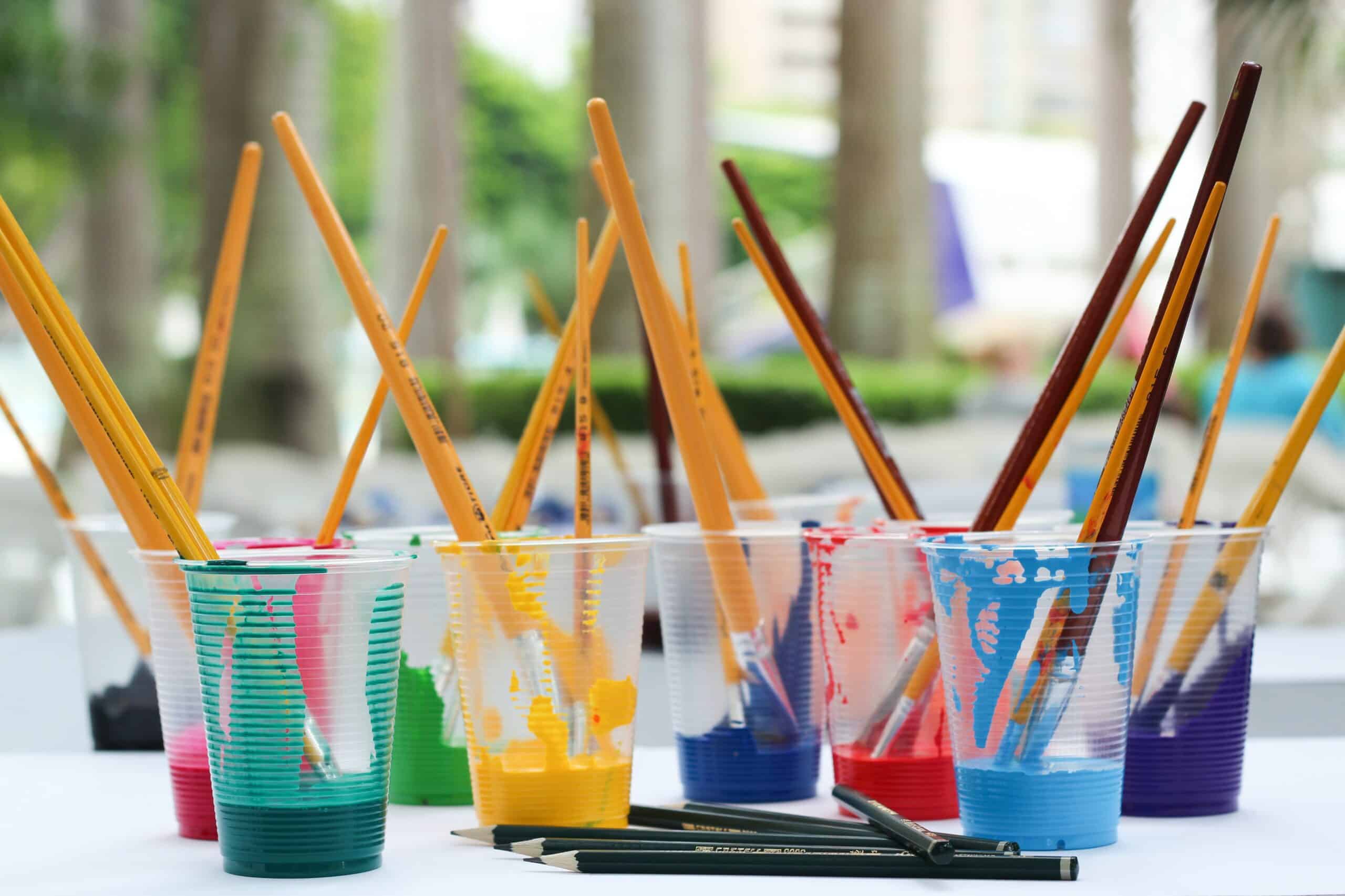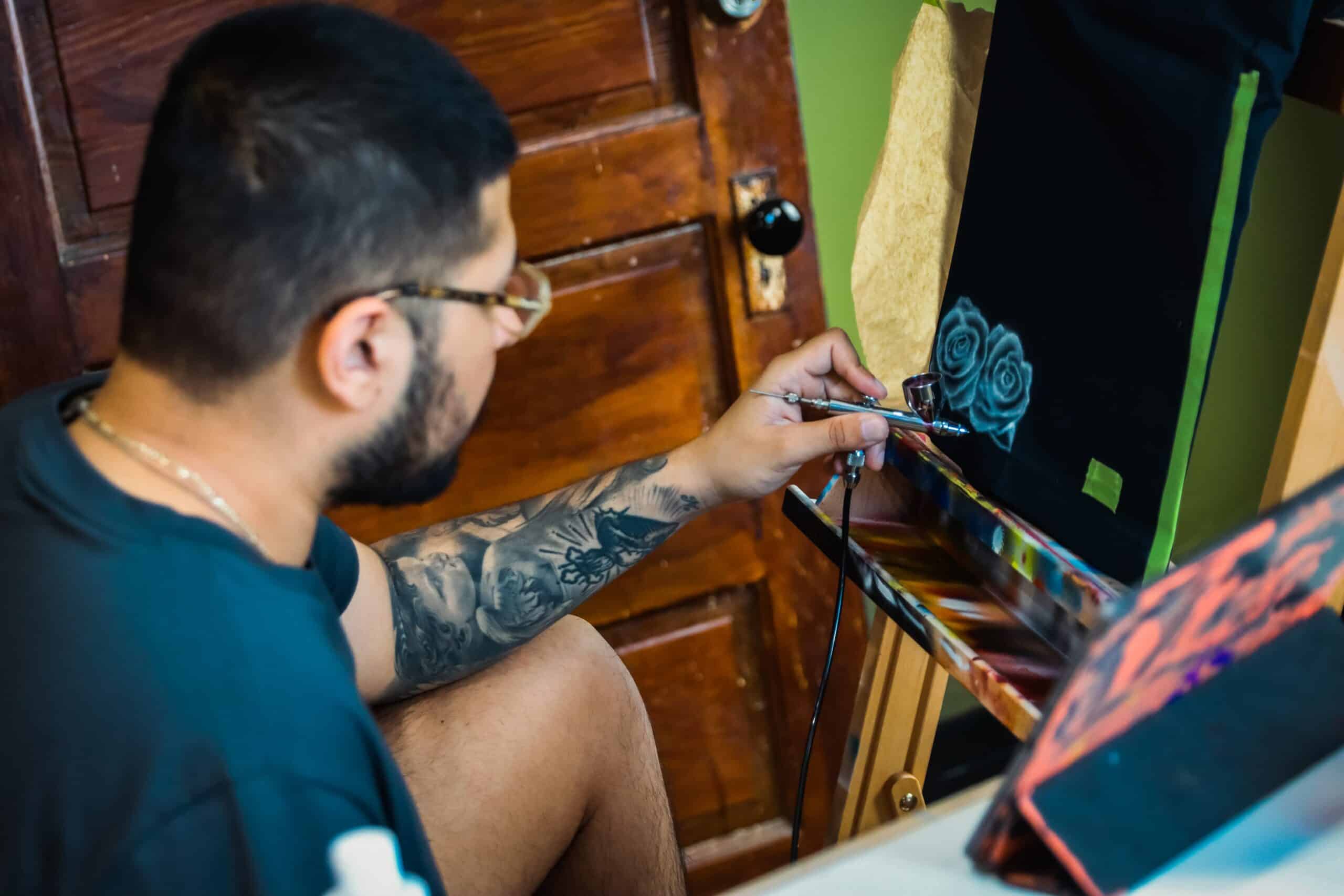How To Thin Acrylic Paint For Airbrush
Are you looking for an easy way to thin acrylic paint for airbrushing? Do you want to expand your airbrush skills and create amazing artwork with ease? If so, then I've got just the guide for you! This article will show you how to easily thin acrylic paint for airbrushing.
Creating stunning artwork with the help of an airbrush can be a fun and rewarding experience. To get started, however, you must understand how to properly prepare your paints. You'll need to make sure they're thinned correctly for them to flow through the airbrush without clogging or spitting out unevenly.
The good news is that thinning acrylic paint doesn't have to be complicated - all it takes is some simple preparation and a few supplies. With my step-by-step instructions, you'll learn exactly what products work best and how to mix them safely and effectively. So let's get started on our journey into learning how to achieve perfect results every time when using acrylics with an airbrush!
Acrylic Paint Thinners
Thinning acrylic paint can be like running a marathon - it takes determination and stamina to get the job done right. When thinning acrylic paints for airbrushing, you'll need two main ingredients: an airbrush thinner and an acrylic thinner. Airbrush thinner helps reduce the thickness of the paint so that it flows through your brush more easily with less clogging or splattering, while acrylic thinner allows you to adjust the viscosity of paint depending on how much pressure is used in your airbrush.
By combining these two elements, you can create a perfect balance between playability and opacity; by adding only enough airbrush thinner to keep your nozzle clear without compromising the vibrancy of color from your acrylics. The result will be smooth coats of even coverage that won’t run together when applied at low pressures.
The beauty of using this method is its versatility – no matter what type of surface you're painting, whether canvas or wood, metal or plastic, there's an ideal ratio that works best for each material based on consistency and application requirements. With practice, finding just the right mix will become second nature as you gain experience working with both airbrush thinner and acrylic thinner in tandem.
So now that we have our mixture ready for action let's move on to talk about all those different types of paint out there!
Types Of Paint
When it comes to airbrush painting, the type of paint you use is paramount for creating a beautiful masterpiece. From mineral spirits and airbrush reducers to acrylic polymer emulsions, there are several distinct types of paints that can be used in an airbrush set.
Using the wrong kind of paint could make all your hard work go down the drain with one spray. It's important to understand each type so you can pick out which one will do the trick for your project.
Mineral spirits offer more control over coverage due to their slow-drying nature. When mixed with a medium such as a linseed oil or turpentine, they create a thin layer ideal for large areas. Airbrush reducer also produces a thin coat but dry faster than mineral spirits making them suitable for smaller projects where precision is key. Lastly, acrylic polymer
emulsion creates a thicker finish perfect for adding texture to your design while still allowing some flexibility when layering colors on top.
No matter what kind of paint you choose, getting the consistency right is essential for any successful airbrushing project.

Different Surfaces
When using an airbrush, the type and surface of materials you are working with can affect how thin or thick your acrylic paint is. In this section, I'm going to discuss different surfaces that will require a thinner paint for successful application.
Firstly, when working with fabric such as t-shirts or hats, you need to make sure that your paint is thinned so it won’t clog up the nozzle size. You also want to ensure that the paint doesn't become distorted by washing - meaning it has to be able to dry quickly and adhere properly. To do this effectively, use an airbrush cleaner designed specifically for cleaning nozzles at least once after each use. This will help keep your nozzle in good condition while helping avoid any blockage due to drying on acrylic craft paint.
In addition, if you plan on applying paper stencils over a painted surface then you'll need to mix some water into your acrylic paints before spraying them onto the material.
Achieving a fine spray pattern is essential for creating detailed designs without ruining any existing work. Make sure not to add too much water because otherwise, it could lead to unwanted splatter from the airbrush nozzle size which can ruin the intricate details of your project.
Thinned-out acrylic paints are ideal for achieving sharp lines and crisp edges when painting both textiles and paper projects with an airbrush; however, it's important not to go overboard in diluting them either! Start off slowly adding small amounts of airbrush cleaner until you get the desired consistency before applying more coats as needed.
Airbrush Nozzle Size
Painting with an airbrush is like creating a masterpiece on canvas. The smooth lines, the intricate details - it's almost magical to watch! But before you get too excited and start airbrushing your next project, there's one important step that needs to be taken: selecting the right nozzle size for your acrylic paint.
Nozzle size can make or break your painting experience. Too small of a nozzle will make it difficult to control the flow of paint, while too large of a nozzle could cause over-spraying and waste products. When using acrylic paint in an airbrush, it’s essential to find the best balance between nozzle size and thinning process for optimal results.
Here are some key points to consider when choosing the right nozzle size for your project:
- Acrylic Paints – Most basic acrylic paints require at least a 0.3mm nozzle diameter so they can pass through without clogging up the airbrush gun.
- Airbrush – Depending on how much pressure you need from your airbrush gun, select a suitable needle/nozzle combination according to its specifications.
- Nozzle Size – Start by experimenting with different sizes until you figure out which works best for your particular application.
Once you've selected the proper nozzle size for your acrylic paint, it's time to move on to the crucial part of preparing them before use: thinning them down appropriately. With careful consideration and experimentation, you'll soon have a better understanding of what works best for each unique situation!

Thinning Process
Thinning acrylic paint for an airbrush is a critical step. Knowing the right thinning process can make or break your project. Isopropyl alcohol and an acrylic polymer emulsion are the two main ingredients used in this process.
First, you'll need to mix the isopropyl alcohol with water in equal parts. Then add some of that mixture into your acrylic paint until it reaches a viscosity similar to skim milk. This should usually take about 25-30% of the total volume of the paint. Finally, add enough acrylic polymer emulsion so that the paint has a glossy finish when it's dry - typically around 10-15%.
It's important to get these ratios right; otherwise, your airbrush performance could suffer due to clogging or overspray problems. And be sure to stir thoroughly before use - as any lumps will also cause blockages within the nozzle! With practice, you'll soon find out which ratio works best for you and your equipment setup. Next up, we look at mixing ratios...
Mixing Ratios
You've come so far in your journey to thinning acrylic paint for airbrush. Now we get down to the specifics of what you need and how much of it you should use. You're almost there! The way you mix your colors will have a huge impact on the final look and feel of your project, so don't rush through this part - all that hard work will pay off soon enough.
When mixing acrylic paint for an airbrush, start with one part paint and two parts thinner. This ratio is a good place to begin because it helps keep the viscosity low while maintaining somebody in the mixture. You can then adjust according to the type of surface you are spraying onto or depending on personal preference. It's essential to take into consideration factors such as humidity levels when deciding how much thinner you want to add; too little could make your mixture thick and clog up your airbrush nozzle, while too much might cause runs and drips on the finished product.
When in doubt, try using small amounts at first until you find out what works best for each individual application.
Finally, once everything has been properly mixed together, be sure to strain the mixture before loading it into your airbrush gun. This step ensures any bits of debris won’t interfere with airflow resulting in better coverage over larger areas without having to reload multiple times. With these tips in mind, you'll be ready to move forward with confidence toward achieving success with acrylic paints for airbrushing!
Flow Improver
When you think of airbrushing and acrylic paint, imagine a river. The flow improver is like the banks that guide it in one direction; without it, the acrylic medium would be all over the place. Adding an acrylic polymer emulsion to your mixture can help strengthen this structure by ensuring the paint moves through the airbrush evenly.
It's important to remember not to add too much though! Too much flow improvement will make your paint runny and create drips rather than a smooth finish on whatever project you may be working on. Start with small amounts at a time and go from there - adding more if needed. You'll find that just a bit of flow improvement goes a long way when thinning out your acrylic paint for use with an airbrush.
Adjusting your ratio until you have achieved the desired consistency takes practice, but once you get used to how different amounts affect your painting process, you'll be able to master it quickly.
With these tips in mind, we’re now ready to move on to discussing airbrush cleaner – another essential element for successful airbrushing projects.
Airbrush Cleaner
When it comes to airbrushing, a good cleaner is key. After all, one of the main reasons for using an airbrush in the first place is for precision and accuracy with your painting job - and you can’t do that if there are clogs or other issues from improper cleaning. Rubbing alcohol works great as an airbrush cleaner when used with Tamiya acrylics, but an auto-air reducer can also be used if necessary.
It's important to remember that the type of paint you use will determine which solvent should be used for airbrush cleaning. Tamiya Acrylic paints require rubbing alcohol while Auto Air Reducer is better suited for automotive paints and clear coats. Make sure whatever product you choose has low volatility so as not to damage any internal parts on your airbrush.
No matter what kind of paint you're working with, keeping your brush clean after each project is essential to prevent clogging - especially if you plan on using different kinds of paints down the road. Keep these tips in mind next time you need some help thinning out your acrylic paint before spraying! With this information at hand, we can move on to discussing solvents-based paints and their uses in our next section.
Solvent-Based Paints

I'm now moving to the next step in thinning acrylic paint for airbrushing: solvent-based paints. Solvent-based paints are a type of paint that can be used with an airbrush, but it's important to note that they do require additional steps and may not always be the best option.
Having said that, if you're looking for something thinner than water-based paints, then these could work well. It's worth mentioning that some solvents can cause damage to your airbrush over time or even dissolve some parts of it, so make sure you research what type of solvent is best suited for your particular model before using it.
The good news is that there are several options available when it comes to solvent-based paints; from mineral spirits and white spirits to acetone and lacquer thinner. Depending on the kind of finish you need and the consistency required in your project, one of these will likely be the right choice.
As I move on to discussing acrylic polymer emulsion and how this might provide another alternative, remember to take into consideration any safety precautions necessary when handling solvents as they can be hazardous materials.
Acrylic Polymer Emulsion
Diving into the world of acrylic paint thinning, we come across a unique and remarkable solution - Acrylic Polymer Emulsion. This product is designed to thin down your airbrush colors in order to achieve smooth finishes with minimal effort. From its technical data sheet, one can see that it has all the necessary components for creating a great airbrushing experience - from low viscosity levels to color retention, and improved adhesion properties.
When compared to solvent-based paints, this emulsion offers more versatility in terms of consistency and control over the outcome of your work. In addition, it's easier on the environment as well since fewer hazardous chemicals are used in its production process. As an added bonus, you'll also be able to save money thanks to its cost-effectiveness when considering long-term use.
TIP: Refer to the manufacturer’s technical data sheet before using any acrylic polymer emulsion off-the-shelf – this will help ensure that you're following best practices while safely enjoying your airbrushing session! With these guidelines followed correctly, you can look forward to achieving beautiful results with every stroke of your brush!
Acrylic Binder
In the world of airbrush painting, an acrylic binder is a must-have. It’s an essential ingredient in creating thinned-out metallic acrylic paint that can be used with an airbrush. As I prepared to begin my latest masterpiece, I couldn't help but marvel at the power of this magical elixir.
The acrylic binder helps hold pigments together and keeps them suspended in a liquid state, even when they're mixed with thinner ratio components like water or alcohol. When combined with these other ingredients, it creates a smooth and consistent consistency which is perfect for precise airbrushing techniques. Plus, because it's non-toxic and odorless, there are no worries about possible reactions when mixing paints or inhaling fumes from overworked brushes.
It's not just its practical benefits that make acrylic binders so important either - its versatility makes it a great choice for all types of projects. Whether you're using matte or glossy finishes, opaque or transparent colors - Acrylic Binder has your back! With one simple step, you'll have everything you need to create stunningly realistic works of art every time.

Thinner Ratio
When it comes to airbrush painting with acrylic paint, the thinner ratio is a key factor in achieving successful results. The right mix of thinner and paint can make all the difference between an enjoyable experience and one filled with frustration. And so, I’ll go over how to get that just-right mixture for optimal performance.
First off, I should mention some basics about thinning acrylic paint for airbrushing:
- Use distilled water as your thinner – plain tap water often contains minerals that could cause clogging;
- Never use more than 25% thinner compared to the amount of paint you are using;
- If the nozzle on your airbrush is small, then reduce this percentage even further (to around 10%); and finally,
- It's best to experiment until you find the perfect balance for your particular application.
Now that we have these essential points out of the way, let’s move on to getting that ideal ratio when working with acrylic paints for airbrushing. To do this properly requires patience and practice—but don't worry! Once you take the time to hone in on what works best for you and your project, everything else will become much easier from there onwards. Try starting out by mixing smaller batches of paint first before moving on to larger ones - this will give you a better idea of how different ratios affect coverage and flow rate. By experimenting along these lines, you'll soon be able to create custom mixes tailored specifically to your own unique needs and preferences regarding airbrush painting with acrylic paint. Moving forward…
Technical Data Sheet
Many people might think that they don't need to consult the technical data sheet when thinning acrylic paint for airbrush. However, this document is an essential step in understanding exactly how to safely and accurately adjust paint viscosity with a thinner of your choice. It will provide you with critical information about nozzle size, binding agent concentration, and other details on water-based paints.
When preparing to thin acrylic paint for airbrushing projects, make sure to look over the manufacturer's technical data sheet. This should be consulted before adjusting any ratios or adding solvents/water as there may be specific guidelines given by the manufacturer concerning mm nozzles and concentrations of binders used in their water-based paints. Knowing these details can help ensure successful results while avoiding damaging consequences such as clogging nozzles or causing issues with adhesion due to incorrect solvent mix ratio dilution.
If you're looking for detailed instructions on thinning acrylic paint for airbrushing tasks, consulting the technical data sheet is key! That said, it's important not to forget to take into account safety measures too -- which we'll discuss next!
Safety Data Sheet
Safety is an important factor when it comes to thinning acrylic paint for airbrushes. That's why I'm now taking a closer look at the safety data sheet (SDS). This document will help me understand what precautions need to be taken and how best to handle this material safely.
The SDS states that while I may use either distilled or tap water to thin acrylic paint, there are some other considerations worth noting. For instance, wearing protective gloves and eye protection is recommended in order to avoid any potential skin irritation from prolonged contact with the paint.
Additionally, proper ventilation should be provided within the workspace whenever possible and all used materials must be disposed of correctly once finished.
Finally, before using any chemicals such as solvents or mediums for further thinning of the paint, it’s essential to read their respective SDS documents first so that all necessary steps can be taken towards ensuring safe handling and usage of these materials. With this information in hand and following sensible safety practices, I'll have no problem moving on to getting the best results out of my project!
Best Results
I'm sure you're looking forward to getting the best results with your airbrush acrylic paint. After all, who doesn't want a smooth, even finish on their projects? So let's take a look at some tips and tricks for achieving this.
First of all, if you don’t already own it, consider investing in Golden Airbrush Medium – especially if you plan on doing a lot of airbrushing in the future. This product is specifically designed to thin out acrylics without compromising quality or color vibrancy. You can also use store-bought thinner such as mineral spirits or distilled water. However, be aware that these won’t mix quite as well with Createx Airbrush Paint as Golden does.
Finally, when using any type of thinner with your acrylic paints, make sure to test it first! It may require more than one try before finding the perfect ratio of paint and medium for optimal performance from your airbrush gun. Don't forget that different brands have different viscosities too so experiment until you get what works best for you!
Conclusion
To conclude, thinning acrylic paint for airbrush is a fairly simple process and can be done easily with the right materials. You must first consider what type of paint you are using, as well as which surface it will be sprayed on to determine the best amount of thinner needed to achieve optimal results.
When using an airbrush nozzle, keep in mind that smaller nozzles require more pressure when spraying, so use a thinner ratio between 8:1 or 10:1 parts paint to 1 part thinner. Additionally, always refer to the technical data sheet and safety data sheets before beginning painting projects to ensure safe handling and usage practices.
Finally, according to a recent survey conducted by The National Airbrush Association (NAA), up to 80% of artists reported achieving better results with their airbrushing techniques after learning how to properly thin their acrylic paints for spray applications. As such, thinning your own acrylic paints for airbrushing can significantly improve the quality of your work!






